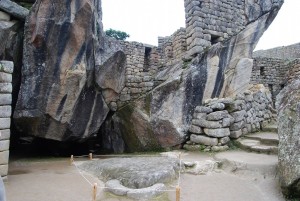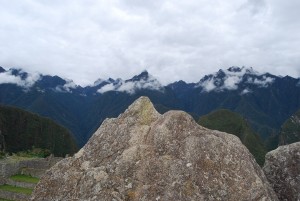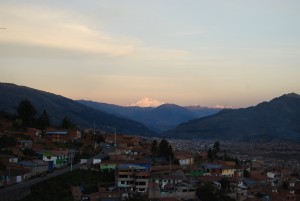Condors and Stone, A Conversation

Some stories tell of how potatoes came from stones, originally, and how one of the first Incas, Ayar Uchu became stone. Stone was very important in Inca life as one can see from the amazing walls and buildings of Cuzco and nearby sites. But stone, which to people of the West is mostly just matter, has much more significance and meaning to people in Cuzco. In what follows Cuzco Eats presents a conversation among the three of us about stone.
Walter: In Machu Picchu, while visiting each important temple, I came on the Temple of the Condor. It contains an image of a condor’s head and body carved in stone on the ground, and then two large stones with some construction on them, that are the condor’s wings. While there I was impressed with the image of the condor as if emerging out of the mountain’s rock, at the same time I felt a strong and pure energy which, when my eyes were closed and my mind calm, allowed me to feel things beyond what we ordinarily see and perceive.
David: I know the experience of being in Machu Picchu gives a strong impression. I have also experienced something like what you describe the times I have gone. But I also wonder about the feeling that you describe. Is it something that is born in you, or something you have been taught?
Walter: The truth is that all of this sensitivity to feelings in a place is born within me. Maybe it is because I am from this beautiful place, Cuzco, or maybe because of the energy that I have from being part of this culture. These feelings are inside me and I feel them very strongly in my heart.
Perhaps I don’t feel what other people feel, since they may only see the images or they may imagine something inside themselves. For that reason they may feel some kind of energy. But I feel something different. I do’t only see the things as they are or the stories that the guides tell. It is more. For me there is more than what can simply be seen. You can only feel that inside your heart, your sonqo.


David: The heart, the sonqo, seems very important. When I lived in an Aymara speaking community on Lake Titicaca I used to hear people say all the time, to talk about something they felt or believed deeply “taqi chuymaxampi” which means with all my heart (although chuyma is more a power, a strength. So I can say the heart is very important in Andean culture, including that of Cuzco. But I wonder if the sonqo doesn’t also get trained by the experiences that you have had. Maybe you have run into condors other times and that impacts your feelings?
Walter: Of course. I am from this place and I have all of this inside me. Everything i do as to first be born in my heart, then it goes to my mind, and then it comes out of my mouth for me to be able to accomplish it. That is what my parents taught me and what I feel inside.
I have run into real condors several times. The first time was when I did a long trek towards Choquequirao. The zone of high mountains was more or less at the beginning of the long walk. We were already going downhill from the pass. Suddenly, in the wind, two beautiful condors appeared. I was really impressed. They were only like ten meters away from us. Inside me I just understood that they demonstrated the duality, since they were male and female. Then that they were a good sign and a good omen for us because they meant that the Apus, the high mountains were on our side and were welcoming us to this place.
I felt very happy and we were filled with good energy. They flew around us with their enormous wings for most of the descent. At one point they even showed us the way.
It was very important for me to be part of this welcome that was given to us by our Apus. That is how I feel, and each time I feel more, especially as a learn more of my culture. I know that I am in the right path since the Apus are always with me. Maybe not all of us have the opportunity to appreciate this. But that is why those kinds of things happen. That is how I understand it.
To run into a pair of condos is really a great honor. Not everyone can have the luck to appreciate so closely their flight of two condors. They are the messengers of the Apus who give us welcome and permission to be able to visit and walk through the mountains to arrive at our destination, Choquequirao.
To be part of such a reception indicates a very good omen and a sign that we are welcome

David: Does the condor of stone in Machu Picchu make you feel something different from running into a condor in the wild, or is it the same?
Walter: It is the same feeling, the same energy. It is just like how I feel it in my heart. It is really very impressive for me. The more I understand these things the more I get closer to good answers. And I think those answers are inside me.
Hebert: I heard from my friends that when the solstice arrives, the 21st of June, the son begins to illuminate the huaca–sacred place–called the Heart of the Pacha (mother earth) which is just a few meters from what is called today the Temple of the Moon above Cuzco. There is a place inside it where the sun illuminates and on that day brings out the form of the three animals that are together called the Andean Trilogy: the serpent, the puma, and the condor. They are there together in the stone and they fly as the sun enters.
My friends said that the serpent represents the inside of the earth, the puma represents the earthly and the condor suggests wisdom since it is looking at you from the heights.
Walter: I have heard that too. They say that they snake is like people in their infancym the puma is when they are grown up and the condor is when they reach their age of wisdom as older persons.

David: I think you guys are talking about something very important but also something a little mixed with Spanish ideas. People talk about babies coming from inside the earth. I remember reading about how men walk the earth like Pumas and that is the image of an adult male, fierce and strong, and that when they have assumed the responsibility of the community and been jurq’ado, helped with feast sponsorship, and reach the end of the path, they are called mallkus which also means condors, no? It is as if because of their life they have reached great heights where they can see a gread distance and know much wider horizons than ordinary people.
That seems very Andean, but the trilogy sounds vaguely Christian, like an attempt to make something Holy by comparing it to the Trinity.
Hebert: There are also people who say that in Qenqo a site by Sacsayhuaman, there is a place that the sun also illuninates and gives the form of a Puma. That also happens on the solstice.
But the culture of Religion limits you. It puts the idea of an omnipotent God while the Incas had the Andean Worldview, nature.
The Huacas that are a series of sacred sides that like in a cascade drop down all along the sides of the Huatanay Valley, Cuzco’s Valley, you can see figures of animals. You can especially see the serpent, the puma, and the condor.
David: Does the rock in itself, that is the material in which the figures appear, have some special meaning for you? I ask because I think that most people in my country only think of rock as just rock, without more importance. It doesn’t have any greater meaning per se. But I wonder if here, in Peru, if stone does not have some greater significance. What do you think about that?
Hebert: Well, it is true that in other parts of the world stone is just stone. But here in Peru, in the territory of Tawantinsuyo (The Inca Empire) stone has a lot of meaning. It is part of nature which people inhabited. In those times they respected and valued the mother earth, the Pachamama, and all of nature.
That is why you can see Inca architecture taking the form it does. Even today, there are many people who follow this way.
David: Yes, it reminds me of the stories of the Ayar brothers and sisters who were the first Incas according to some stories. They left three of the brothers as stone in the land. They became rock, they petrified, so that when the Incas made offerings to nature, the Earth, they would have their siblings there to help them. This theme of stone and people becoming stone, or finding models in stone and taking great feelings from stone is a very important one for understanding the people of Cuzco. Thank you.





Hey!
I’m one of Mandy Laws archaeology students that is going to go to Peru next May. I just wanted to say how cool it is to read about how you guys view the world differently than I do. I also think it’s really interesting how we think the same way in some aspects as well. Walter said: “Everything i do as to first be born in my heart, then it goes to my mind, and then it comes out of my mouth for me to be able to accomplish it. That is what my parents taught me and what I feel inside.” that is exactly how I feel with my own religous views. I have to feel it in my heart, then know it in my head, and then apply it to my words and actions.
I think it’s really cool how we can be different and the same, at the same time.
Walter here.
Hi Sidnee It is nice to meet you and to know that you like our article. It is also good to know that there is another person who thinks the same way I do. I think it is good that when we do things we should do them with full heart. I am glad that you will be visiting Peru and we look forward to welcoming you. I imagine you will come to Cusco. I am from there and if you need any help you can write me care of Cuzco Eats and I will get back with you. We send you a lot of good energy from Cusco.